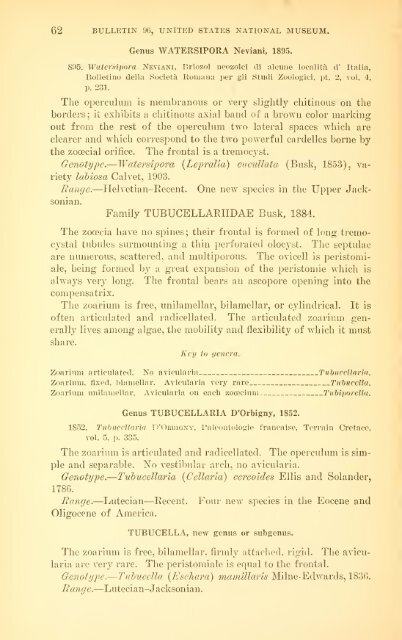Bulletin - United States National Museum - Smithsonian Institution
Bulletin - United States National Museum - Smithsonian Institution
Bulletin - United States National Museum - Smithsonian Institution
You also want an ePaper? Increase the reach of your titles
YUMPU automatically turns print PDFs into web optimized ePapers that Google loves.
62 BULLETIN 96, UNITED STATES NATIONAL MUSEUM.<br />
Genus WATERSIPORA Neviani, 1895.<br />
805. Watcrsipora Neviani, Briozoi iieozoici di alcune localita d' Italia,<br />
BoUetino della Societa Koiuaua per gli Studi Zoologici, i^t. 2, vol. 4,<br />
p. 231.<br />
The operculum is membranous or very slightlj'' chitinous on the<br />
borders; it exhibits a chitinous axial band of a brown color marking<br />
out from the rest of the operculum two lateral spaces which are<br />
clearer and which correspond to the two powerful cardelles borne by<br />
the zocecial orifice. The frontal is a tremocyst.<br />
Genotype.— Watersipora {Lepral'ia) cucullata (Busk, 1853), va-<br />
riety labiosa Calvet, 1903.<br />
Range.—Helvetian-Eecent. One new species in the Upper Jack-<br />
sonian.<br />
Family TUBUCELLARIIDAE Busk, 1884.<br />
The zooecia have no spines ; their frontal is formed of long tremo-<br />
cystal tubules surmounting a thin perforated olocyst. The septulae<br />
are numerous, scattered, and multiporous. The ovicell is peristomi-<br />
ale, being formed by a great expansion of the peristomie which is<br />
always very long.<br />
compensatrix.<br />
The frontal bears an ascopore opening into the<br />
The zoarium is free, unilamellar, bilamellar, or cylindrical. It is<br />
often articulated and radicellated. The articulated zoarium generally<br />
lives among algae, the mobility and flexibility of which it must<br />
share.<br />
Kcij to genera.<br />
Zoarinm articulated. No avicularia TnhuecUaria.<br />
Zoarium. fixed, hiamellar. Avicularia very rare TuhueeUa.<br />
Zoarium unilamellar. Avicularia on each zooecium Tiihiporclla.<br />
Genus TUBUCELLARIA D'Orbigny, 1852.<br />
1852. TnbuecJlarut D'Orbigny, Paleoutologie francaise, Terrain Cretace,<br />
vol. 5, p. 335.<br />
The zoarium is articulated and radicellated. The operculum is sim-<br />
ple and separable. No vestibular arch, no avicularia.<br />
Genotype.—Tubucellaria {Cellaria) cereoides Ellis and Solander,<br />
1786.<br />
Range.—Lutecian—Recent. Four new species in the Eocene and<br />
Oligocene of America.<br />
TUBUCELLA, new^ genus or subgenus.<br />
The zoarium is free, bilamellar. firmly attached, rigid. The avicu-<br />
laria are very rare. The peristomiale is equal to the frontal.<br />
Genotype.—Tubucella {Eschara) mamillaris Milne-Edwards, 183C.<br />
Range.—Lutecian-Jacksonian.

















